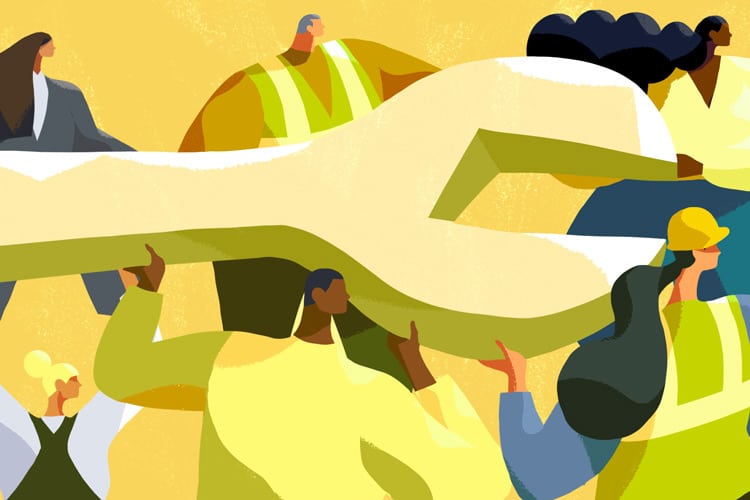Illustration by Kim Salt
It’s no secret that the construction industry is one of the most rapidly evolving sectors of the global economy. Thanks to industry-wide changes including the use of 3D printing, modular building technology and digital transformation, construction is undergoing arguably one of the most dramatic technological shifts since the Industrial Revolution.
According to Dr. Jack Dennerlein, co-director of Harvard’s Center for Work, Health, and Well-being, these changes may come with an increase in worker anxiety. Workers, particularly those with more career experience, are afraid that the impact of technology on the construction industry may result in them being left behind. And more often than not, companies don’t do a good job of addressing these anxieties on an organizational level.
“The problem is that you have competing demands within the organization,” Dennerlein said. A desire for the increased speed or efficiency of production that come with the use of new technologies can be slowed by inefficient communication within an organization whose members may feel their positions are threatened by such rapid change.
As a result, how should the industry introduce technological change while minimizing resistance? The answer, Dennerlein said, is to focus on the big picture.
Manage workplace culture
When introducing major changes to a workplace amid the impact of technology on the construction industry, it’s important that companies develop a realistic sense of how its organization functions.
“At the center, we look at social technical systems, which is the organizational structure of construction and how that impacts worker health, safety and well-being,” Dennerlein said. “We look at how work is organized, what the demands are on workers and how they’re supported by their supervisors—the social, technical and organizational structure.”
Only by developing an accurate sense of the unique structure and needs of a particular workplace can construction firms begin making the large-scale technological and interpersonal changes that today’s rapidly evolving industry demands.
In the beginning of introducing a new concept or technology, however, Dennerlein recommends developing an in-depth understanding of how the company works and how the proposed change will meet the firm’s particular needs.
“Every company is different in how it’s structured: the personalities of the people who work there, the issues that it is facing, what’s working and what’s not working,” Dennerlein said. “So, to come in with a very prescriptive solution isn’t really fair, even though that’s what they might want. You really need to give them something they can adapt and sustain on their own.”
Instead of presenting employees with a finished product—whether that be the logistics of a technological shift or a change in their responsibilities and the company structure resulting from it—involve employees in the decision-making process to help them feel personally invested in the company’s growth.
Reduce resistance to change
The Center for Work, Health and Wellbeing has a very specific process for assessing what changes need to occur within a workplace as the impact of emerging technologies on the construction industry takes hold.
Although the issues it helps companies address vary in nature and occur in businesses at every level—from multinational corporations to small firms—Dennerlein said that it always starts with the same questions for employees and stakeholders.
“We talk about what’s good,” Dennerlein said, explaining that his firm always strives to make space for employees to celebrate the positive aspects of their workplaces and to celebrate what’s working about the organization’s systems and technologies.
“By talking about what works,” he continued, “we get people to focus on the positive. We encourage them to focus on what’s working and to feel proud of their contributions to the workplace. This gives them a space to see a model that works and to understand how the changes we’re going to make together will contribute to supporting the positive aspects of how the organization is functioning.”
Starting on a positive note allows employees to understand how their contributions to change will support the healthy functioning of their company as technology continues to reshape the construction industry, but it also shows how it will impact their own daily work experiences.
“What it does is create a dialogue, where they can explore the solutions and explore ideas and explore understanding the concept,” Dennerlein said. “Saying what works gives them some ideas of how to build on past successes.”
Accentuating the positive when creating change also helps workers and management feel connected as a team and to understand the ways they’re building toward a common goal. As Dennerlein put it, when creating change, “don’t just attack your weaknesses—build off your strengths.”
Focus on communication
The most common reason for change to cause employees stress or for progress on a planned technological change to falter is a failure in organizational communication. “There’s so many opportunities for that communication chain to sort of break down,” Dennerlein said.
Especially in multinational organizations, change that makes sense locally can falter when it’s upscaled globally when management hasn’t taken a big-picture approach.
“In a multinational organization you’re going to have places that have different kinds of cultures, where different issues may arise—in South America vs. North America or even Texas vs. Massachusetts,” Dennerlein said. But these issues can crop up even in smaller companies, where differences in company culture or the expectations for communication may vary even between divisions.
When bringing change to any organization, Dennerlein believes that it is important that management understands the experience and concerns of front-line workers.
“No matter how big an organization is, they have to understand what it’s like to walk the floor,” Dennerlein said. “A manager should be able to understand what’s going on at the front line of their organization and how the decisions they’re making may impact everybody down below. When making a change, they need to realize that there’s this whole organization that will be implementing their policy; they need to understand how that policy disseminates through the company as a whole.”
To create this understanding and effectively implement change in a psychologically and organizationally coherent way, leaders must learn to perceive their company as a whole, understanding how interconnected labor and communication creates a productive atmosphere.
“The infrastructure of the whole organization needs to understand how to be connected to that front-line worker,” Dennerlein said. “By doing that, you create a dialogue. You create a psychological safe space where the workers can communicate back to managers of what the managers’ decisions are doing, how that’s impacting those workers and how they have to deal with that from day to day.”
Only by creating this cohesive understanding can a company effectively implement change.











